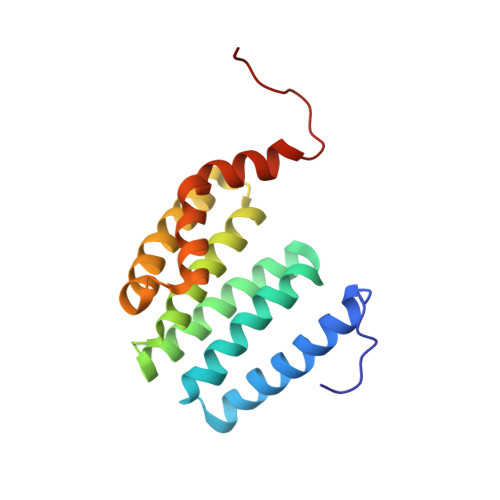Convergent evolution of receptors for protein import into mitochondria
Perry, A.J., Hulett, J.M., Likic, V.A., Lithgow, T., Gooley, P.R.(2006) Curr Biol 16: 221-229
- PubMed: 16461275
- DOI: https://doi.org/10.1016/j.cub.2005.12.034
- Primary Citation of Related Structures:
1ZU2 - PubMed Abstract:
Mitochondria evolved from intracellular bacterial symbionts. Establishing mitochondria as organelles required a molecular machine to import proteins across the mitochondrial outer membrane. This machinery, the TOM complex, is composed of at least seven component parts, and its creation and evolution represented a sizeable challenge. Although there is good evidence that a core TOM complex, composed of three subunits, was established in the protomitochondria, we suggest that the receptor component of the TOM complex arose later in the evolution of this machine. We have solved by nuclear magnetic resonance the structure of the presequence binding receptor from the TOM complex of the plant Arabidopsis thaliana. The protein fold suggests that this protein, AtTom20, belongs to the tetratricopeptide repeat (TPR) superfamily, but it is unusual in that it contains insertions lengthening the helices of each TPR motif. Peptide titrations map the presequence binding site to a groove of the concave surface of the receptor. In vitro functional assays and peptide titrations suggest that the plant Tom20 is functionally equivalent to fungal and animal Tom20s. Comparison of the sequence and structure of Tom20 from plants and animals suggests that these two presequence binding receptors evolved from two distinct ancestral genes following the split of the animal and plant lineages. The need to bind equivalent mitochondrial targeting sequences and to make similar interactions within an equivalent protein translocation machine has driven the convergent evolution of two distinct proteins to a common structure and function.
Organizational Affiliation:
Department of Biochemistry and Molecular Biology, Bio21 Institute of Molecular Science and Biotechnology, University of Melbourne, Parkville, Victoria 3010, Australia.














